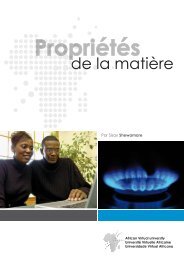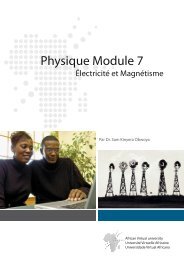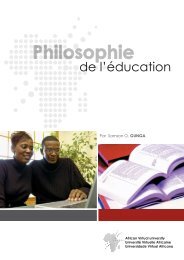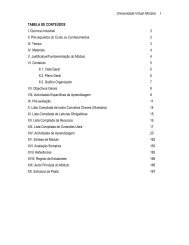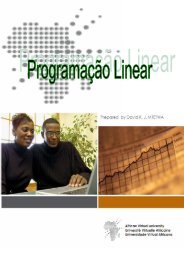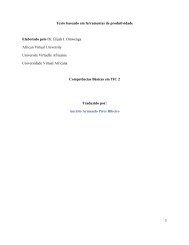Physical Chemistry 2.pdf - OER@AVU - African Virtual University
Physical Chemistry 2.pdf - OER@AVU - African Virtual University
Physical Chemistry 2.pdf - OER@AVU - African Virtual University
Create successful ePaper yourself
Turn your PDF publications into a flip-book with our unique Google optimized e-Paper software.
1.8 Ideal solutions<br />
µA(g)<br />
A(g), B(g)<br />
µA(l)<br />
A(l), B(l)<br />
<strong>African</strong> <strong>Virtual</strong> <strong>University</strong><br />
Figure 1.6 The chemical potential of the gaseous form of the pure substance A,<br />
µA(g), equals that of the pure liquid A, µA).<br />
To consider the chemical potential of liquids we first consider the equilibrium that<br />
exists between a liquid and its vapour pressure. We make use of the fact that at equilibrium,<br />
the chemical potential of a substance in the liquid is equal to the chemical<br />
potential of the substance in the vapour. Let us consider a pure liquid A with chemi-<br />
* *<br />
cal potential µ A ( l)<br />
with a vapour pressure P A . The chemical potential for the pure<br />
liquid A can be written as<br />
*<br />
* ° PA µ A (l) = µA +RT ln<br />
⎛ ⎞<br />
⎝<br />
⎜<br />
P° ⎠<br />
⎟<br />
(1.18)<br />
If another solute was introduced into to the liquid then the vapour pressure above<br />
is no longer that of the pure substance<br />
potential is thus given by<br />
µ<br />
A<br />
( l)<br />
µ<br />
= °<br />
A<br />
⎛ PA<br />
⎞<br />
+ RT ln⎜<br />
⎟<br />
⎝ P°<br />
⎠<br />
*<br />
P A but the partial pressure P . The chemical<br />
A<br />
(1.19)<br />
By combining equations (1.18) and (1.19) we obtain the equation (1.20), without the<br />
standard chemical potential of the gas.





